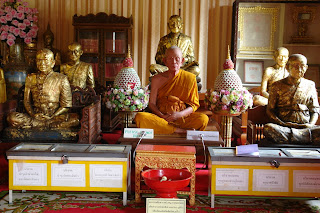As the prayers of people rise upwards like the burnt incense that drift towards heaven, the people of Chiang Mai seem to yearn for a better tomorrow, for the possibility of miracles and abundant blessing. While worshippers bend down in reverence, meditating on an unseen eternity, the past is equally cherished.
The reflected celebration of the past is vibrantly displayed through gold and carved stone of the various temples that litter the busy city, but also in remembrance of such myths like the of the fate of an incredibly handsome monk by the name of Sangkachai, who could not reciprocate the love of a boy who was infatuated with him; the monk, feeling heavily guilty, prayed desperately that he could diminish in physical allure, upon discovering the disastrous effect of infatuation and good looks.
His prayers were answered; Sangkachai turned obese and remained so for the rest of his life.
The plump-figured Buddha statue featured within part of the precinct of Wat Chedi Luang is an emblem of this sad story. Statues that surround the temple Wat Chedi Luang, exemplify how ancient myth and history are immortalized in stone and statue. Wat Chedi Luang portrays the thirst for divine intervention.

In front of Wat Chedi Luang
The chedi houses the statue of Buddha, its towering structure, which elevates the figure of the Buddha to a height that is beyond physical accessibility, though not dampening the incessant desire of devotees towards worship. Wires that traverse the distance from ground level to the height of the chedi allow the devotees to deliver offerings via the mere action of a pulley. After the meticulous folding and arrangement of lotus leaves, flowers, fruit and incense sticks within a basket, the offering is deftly delivered towards heaven, while incurring postal charges that would constitute donations.
According to a 25-year-old monk, Phasomchai, the towering Chedi was also once utilized as a shelter for the monks during times of war or conflict. Elephants were stationed outside the tower to guard its safety- hence the presence of statues of elephant heads is evident, as they surround the chedi
The temple of Wat Phra Singh similarly houses intricate gold carvings, featuring the Phra Singh Buddha image, whereby the word Phra refers to Buddha images. The meaning of the word Phra is reified when several golden Buddha figures sit behind the altar within the main prayer hall of the temple; pilgrims of the temple offer gifts at the altar in the form of a combination of banana fruit and flowers, also known as Kakrong Sedokok. Offerings are accompanied by slips of papers containing the pilgrims’ names, date of birth and other relevant details. The devotees place their offerings at the altar with hopes of good luck. Wat Phra Singh displays an embalmed deceased monk, a prominent leader whose name was Kruba Sriwichai.

Chief Abbot Kruba Sriwichai
Rich in carving and statues, ghosts of the past linger, embodied in stone, gold and embalming fluid. Devotees at Wat Phra Singh sit before the embalmed monk figure, praying for blessing. Other devotees are seen kneeling before monks who sit cross legged, sprinkling water over shoulders of devotees as a gesture of blessing. While the embalmed figure sits as if in pensive thought, his eyes fixated in a faraway gaze, believers mimic his stance, placing hopes for certainty in a distant future as they appeal for miracles.
For the monks, religion is a paramount force. For lucid-minded 67-year-old Phrakruwittan, monkhood has dominated his life for 50 years. He explained that he chose this path because he wanted to learn more about Buddhism. On the other hand, the shy and soft spoken 25-year-old Phasomchai explained that he had dedicated his life to meditative solitude since the tender age of 12.

Sai Sin: protective strings for blessings
Evidently then, there is no doubt that religion permeates the lives of people in Chiang Mai.

No comments:
Post a Comment